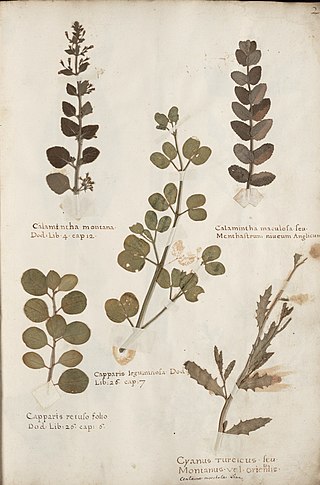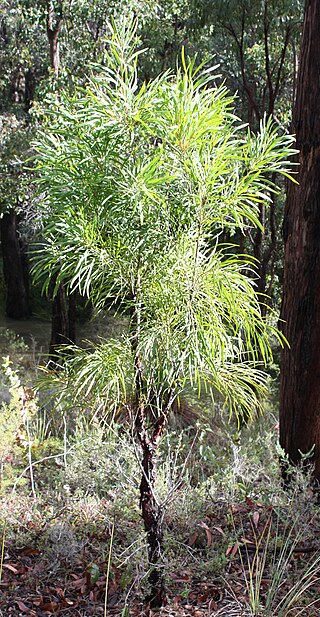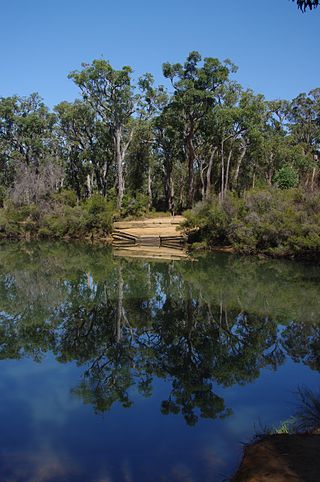Related Research Articles

A herbarium is a collection of preserved plant specimens and associated data used for scientific study.
The Kimberley is the northernmost of the nine regions of Western Australia. It is bordered on the west by the Indian Ocean, on the north by the Timor Sea, on the south by the Great Sandy and Tanami deserts in the region of the Pilbara, and on the east by the Northern Territory.

The Australian National Botanic Gardens (ANBG) is a heritage-listed botanical garden located in Acton, Canberra, in the Australian Capital Territory, Australia. Established in 1949, the Gardens is administered by the Australian Government's Department of Agriculture, Water and the Environment. The botanic gardens was added to the Commonwealth Heritage List on 22 June 2004.

Alexander Segger George is an Australian botanist. He is an authority on the plant genera Banksia and Dryandra. The "bizarre" Restionaceae genus Alexgeorgea was named in his honour in 1976.

Persoonia longifolia, commonly known as snottygobble, is a species of flowering plant in the family Proteaceae and is endemic to the southwest of Western Australia. It is a shrub or small tree characterised by its weeping foliage, yellow flowers and distinctive flaky bark.
FloraBase is a public access web-based database of the flora of Western Australia. It provides authoritative scientific information on 12,978 taxa, including descriptions, maps, images, conservation status and nomenclatural details. 1,272 alien taxa are also recorded.
The Water and Rivers Commission is a defunct agency of the Government of Western Australia. Established on 1 January 1996, it was set up under the Water and Rivers Commission Act 1995, to administer the Act and other legislation relevant to development and conservation of Western Australia's water resources.

Neville Graeme Marchant is a retired Western Australian botanist. He was formerly the Director of the Western Australian Herbarium.

The flora of Western Australia comprises 10,551 published native vascular plant species and a further 1,131 unpublished species. They occur within 1,543 genera from 211 families; there are also 1,317 naturalised alien or invasive plant species more commonly known as weeds. There are an estimated 150,000 cryptogam species or nonvascular plants which include lichens, and fungi although only 1,786 species have been published, with 948 algae and 672 lichen the majority.

Whicher Range, also known as Whicher Scarp, is a range in the South West region of Western Australia.
Persoonia rufiflora is a species of flowering plant in the family Proteaceae and is endemic to the south-west of Western Australia. It is an erect, sometimes spreading shrub with hairy young branchlets, lance-shaped to linear leaves, and hairy, greenish yellow flowers arranged singly or in pairs.

The State Herbarium of South Australia, sometimes called the South Australian Herbarium, and having the herbarium code, AD, is located in Adelaide, South Australia. It is one of several State and Commonwealth herbaria in Australia. The Department for Environment and Water is the state agency which is responsible for the Herbarium, but the Board of the Botanic Gardens and State Herbarium is charged with its establishment and maintenance.
Melaleuca basicephala is a plant in the myrtle family, Myrtaceae and is endemic to the south-west of Western Australia. It is a rarely-seen shrub from the dense freshwater swamps of the wet far south-west corner of the state.

Melaleuca pauciflora is a shrub in the myrtle family Myrtaceae, endemic to the south-west of Western Australia. Its decussate leaf arrangement and its small heads of white flowers on the sides of its branches are diagnostic. This is probably the least spectacular of all the melaleucas.

Melaleuca glauca, commonly known as Albany bottlebrush is a plant in the myrtle family, Myrtaceae and is endemic to the south-west of Western Australia. It is a tall shrub with glaucous leaves and spikes of red flowers in spring.

The National Herbarium of New South Wales was established in 1853. The Herbarium has a collection of more than 1.4 million plant specimens, making it the second largest collection of pressed, dried plant specimens in Australia, including scientific and historically significant collections and samples of Australian flora gathered by Joseph Banks and Daniel Solander during the voyage of HMS Endeavour in 1770.
The Australasian Virtual Herbarium (AVH) is an online resource that allows access to plant specimen data held by various Australian and New Zealand herbaria. It is part of the Atlas of Living Australia (ALA), and was formed by the amalgamation of Australia's Virtual Herbarium and NZ Virtual Herbarium. As of 12 August 2014, more than five million specimens of the 8 million and upwards specimens available from participating institutions have been databased.

Patricia May Holmgren is an American botanist. Holmgren's main botanical interests are the flora of the U.S. intermountain west and the genera Tiarella and Thlaspi. Holmgren was the director of the herbarium at the New York Botanical Garden from 1981–2000, and editor of Index Herbariorum from 1974–2008.
FloraNT is a public access web-based database of the Flora of the Northern Territory of Australia. It provides authoritative scientific information on some 4300 native taxa, including descriptions, maps, images, conservation status, nomenclatural details together with names used by various aboriginal groups. Alien taxa are also recorded. Users can access fact sheets on species and some details of the specimens held in the Northern Territory Herbarium, together with keys, and some regional factsheets.
References
- ↑ "Western Australian Herbarium". Department of Parks and Wildlife, Government of Western Australia. Retrieved 8 August 2006.
- ↑ PERTH: Index herbariorum code for the Western Australian Herbarium. Retrieved 24 July 2019.
- ↑ Marchant, Neville (2005) Documenting a flora: a History of the Western Australian Herbarium and its Collections, Early Days: Journal of the Royal Western Australian Historical Society, vol. 12, 2005, pp. 566-83
- ↑ Underwood, Roger (Roger John); Western Australia. Department of Environment and Conservation; Underwood, Roger (2011), A botanical journey : the story of the Western Australian Herbarium, Dept. of Environment and conservation, ISBN 978-1-921703-12-6
- ↑ Green, J. W. "History of early Western Australian herbaria". In Short, P. S. (ed.). History of systematic botany in Australasia. Australian Systematic Botany Society. pp. 23–27. ISBN 0-7316-8463-X.
- ↑ Centre for Transformative Innovation, Swinburne University of Technology. "George, Alexander Segger - Person - Encyclopedia of Australian Science and Innovation". www.eoas.info. Retrieved 7 May 2024.
- ↑ Centre for Transformative Innovation, Swinburne University of Technology. "Weston, Arthur - Person - Encyclopedia of Australian Science and Innovation". www.eoas.info. Retrieved 7 May 2024.
- ↑ Western Australia. Department of Agriculture; Western Australia. Department of Conservation and Land Management; Western Australian Herbarium (1988), Kingia, Western Australian Herbarium, Dept. of Agriculture, ISSN 0819-1247
- ↑ Western Australian Herbarium; Western Australia. Department of Biodiversity, Conservation and Attractions (1978), Western Australian Herbarium Research Notes, Western Australian Herbarium, ISSN 0155-7165